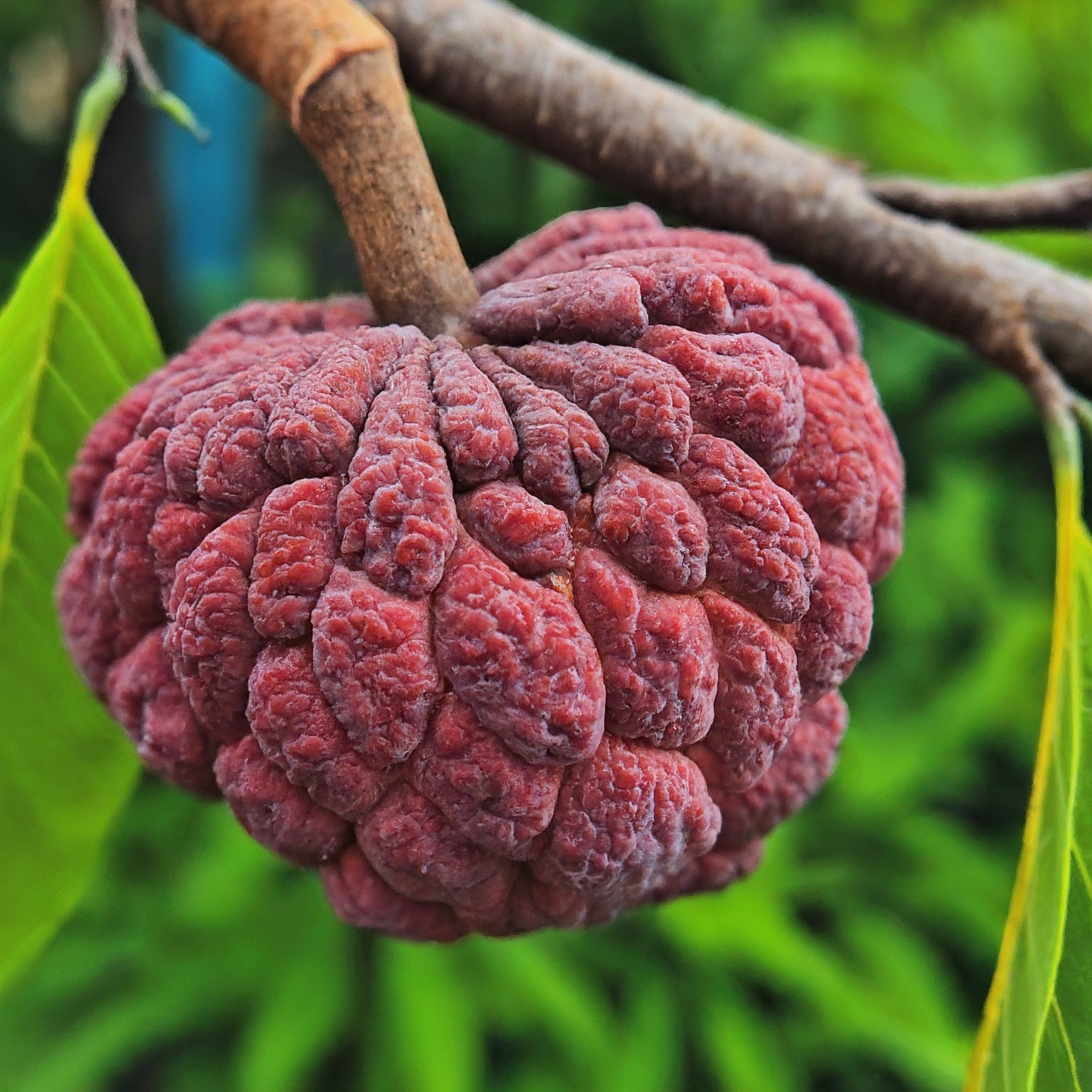The red custard apple, also known as Annona reticulata, sugar apple, or sweetsop, is a tropical fruit that’s not only delicious but also packed with numerous health benefits.
This comprehensive guide will walk you through everything you need to know about growing and caring for a red custard apple tree.
What is a Red Custard Apple?
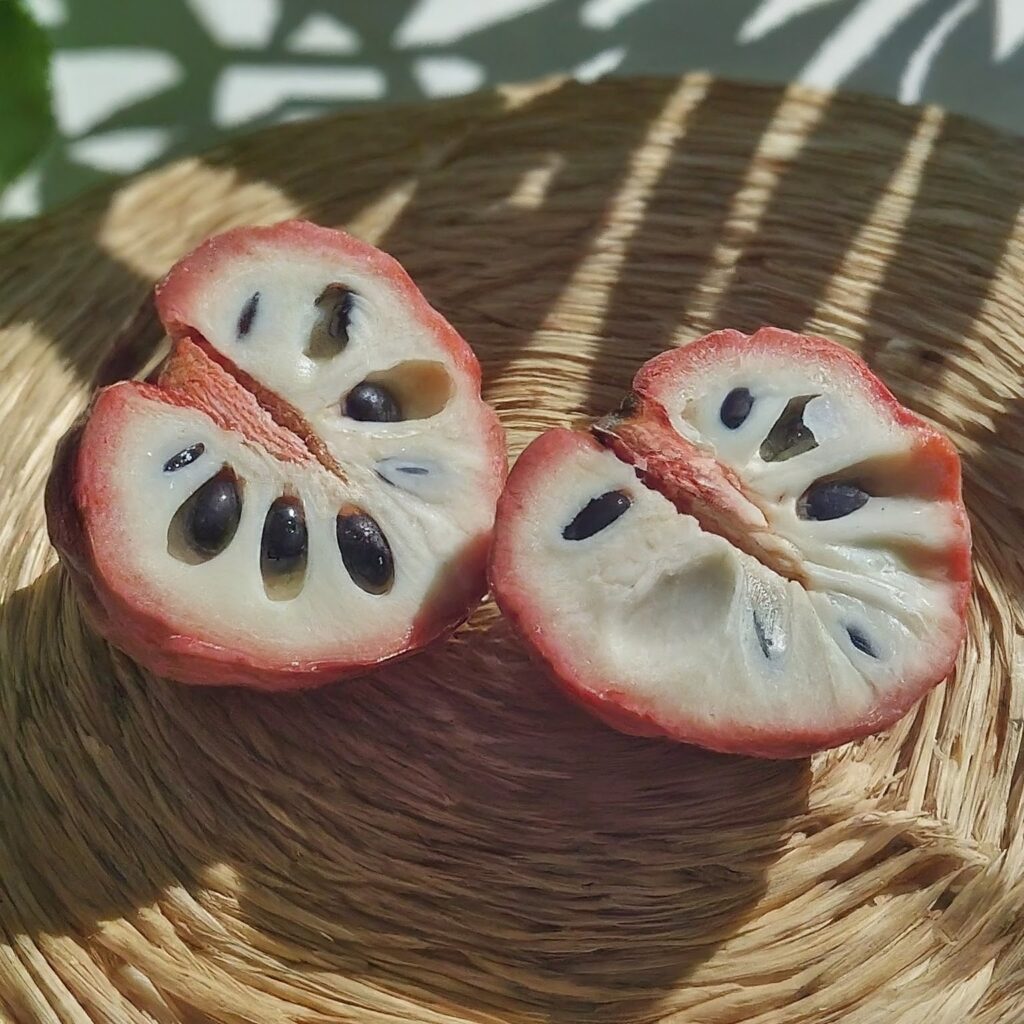
Red custard apple is a tropical fruit native to the Caribbean and Central America.
The tree thrives in warm climates and is now grown in various parts of the world, including Asia, Africa, and parts of the United States. The fruit features a unique, heart-shaped appearance and its rich, creamy flesh that tastes like a blend of banana, pineapple, and strawberry.
The history of the red custard apple dates back to ancient civilizations in Central and South America. Indigenous peoples valued it for its sweet taste and numerous medicinal properties.
Today, it remains a popular fruit due to its delicious flavor and the myriad of health benefits.
Check out this video about the facts and origin of sugar apples and red sugar apples:
How to Grow and Care for a Red Custard Apple Tree
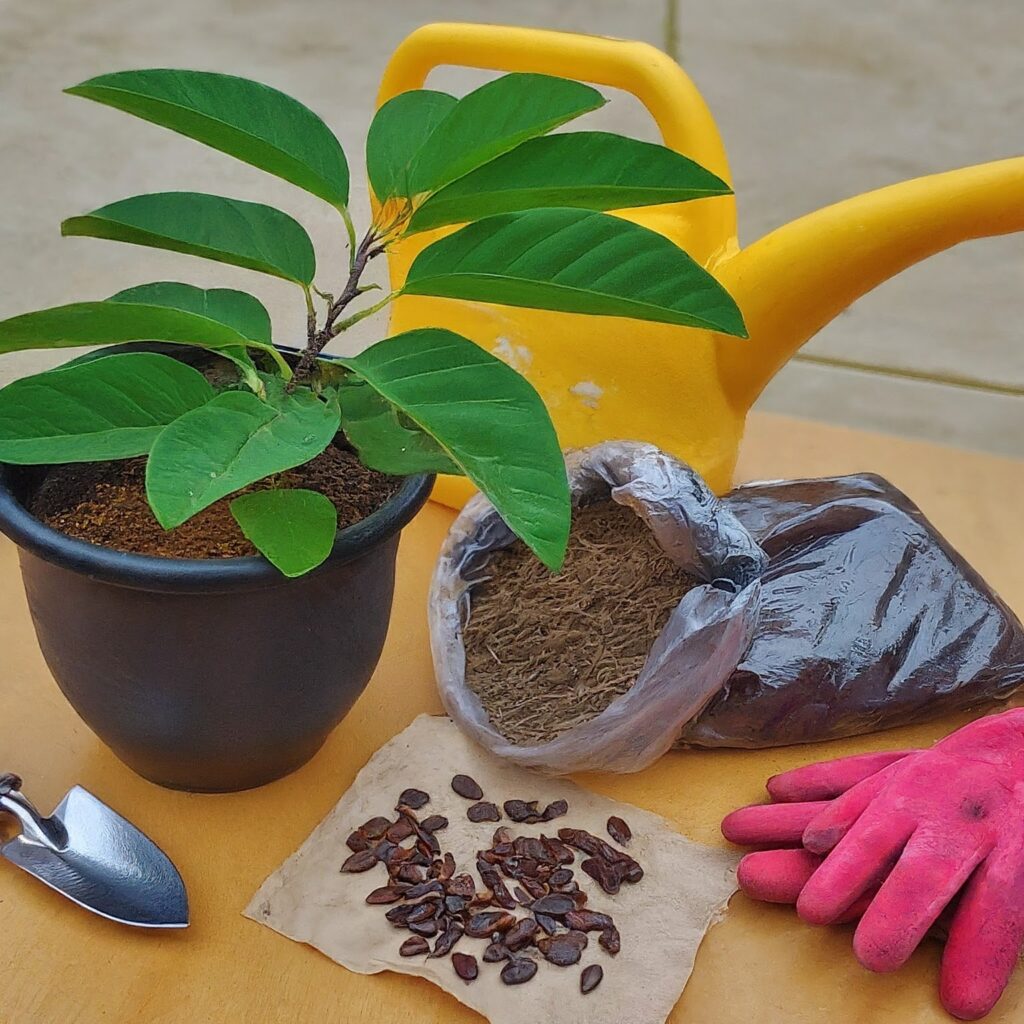
Growing a red custard apple tree might seem daunting at first, but with the right guidance, you’ll see that it’s pretty easy.
Here are the steps to grow a red custard apple tree:
Step 1: Choosing the Right Location
First, consider the red custard apple growing zone.
This tree thrives in USDA hardiness zones 9-11, where the climate is warm and frost-free.
Ensure you have a sunny spot in your garden, as the tree needs full sunlight to grow well.
Full sunlight promotes vigorous growth and abundant fruit production. Avoid areas with strong winds as they can damage the delicate branches and flowers.
Step 2: Preparing the Soil
Red custard apples prefer well-draining soil that’s rich in organic matter.
You can enhance your garden soil by mixing in compost or aged manure. The ideal soil pH is between 6.5 and 7.5.
Ensure the area where you plant the tree has good drainage to prevent waterlogging, which can harm the roots. To improve drainage, you can create raised beds or amend the soil with sand or perlite.
Adding a layer of mulch will help retain moisture and regulate soil temperature.
Step 3: Finding and Planting a Live Red Custard Tree or Seed
You’ve got two options to grow red custard apples.
Option 1: Live Red Custard Plant
Your first option is to plant a live red custard apple tree.
You can find a live plant at local nurseries, specialized fruit tree growers, or reputable online plant retailers. Or you may want to search Google with keyphrases like “red custard apple plant for sale near me.”
Depending on the size and health of the plant, the price can range from $20 to $50. The average size of a young red custard apple plant for sale is usually between 1-3 feet tall.
When choosing your tree, look for one with a healthy root system, free of pests and diseases, and vibrant, green foliage.
Ensure the trunk is straight and sturdy, and avoid trees with damaged or broken branches.
Once found, you should plant your red custard apple tree during the spring when the weather is warm.
Here are the steps for successful planting:
- Digging a Hole: Dig a hole that’s twice as wide and just as deep as the root ball of the tree. This helps the roots to spread out and establish themselves properly.
- Placing the Tree: Gently remove the tree from its container, being careful not to damage the roots. Place the tree in the hole, making sure it’s upright and the trunk is straight.
- Backfilling: Backfill the hole with soil, firmly pressing it down to eliminate air pockets. Ensure the soil is level with the surrounding ground and the tree is stable. Then water the plant thoroughly.
Option 2: Growing Red Custard Apple Tree from Seed
If you’re looking for a more hands-on and rewarding experience, growing a red custard apple plant from seed is an excellent option.
Thankfully, you can find red custard apple seeds from various sources, such as specialty nurseries, online retailers, local farmers markets, and gardening clubs and forums.
Also, you may want to buy a red custard apple from the market and then store and dry the seeds to grow your own tree.
Remember that growing a red custard apple tree from seed is a step-by-step process that requires patience and attention to detail.
Here’s how to do it:
Red custard apple seeds have a hard outer shell, which can make germination slow. Seed scarification can help speed up the process.
- Mechanical Scarification: Gently rub the seeds with sandpaper to slightly abrade the seed coat. Take care not to harm the inner seed.
- Soaking Seeds: After scarification, soak the seeds in warm water for 24-48 hours to further soften the seed coat and promote quicker germination.
- Preparing the Soil: Fill small pots or seed trays with a well-draining seed-starting mix. A blend of peat moss with perlite or sand can be effective.
- Planting Depth: Sow the seeds approximately 1 inch deep in the soil. Cover them lightly and water gently.
- Creating Humidity: Cover the pots or trays with plastic wrap or place them in a propagation dome to maintain humidity. This creates a mini-greenhouse effect, aiding in germination.
- Temperature and Light: Place the seeds in a warm, bright location. A temperature range of 75-85°F (24-29°C) is ideal. If needed, you can use a heat mat to ensure consistent warmth.
- Watering: Maintain consistent soil moisture without making it waterlogged. Check regularly and water as needed to ensure the soil doesn’t dry out.
- Germination Time: Be patient, as germination can take anywhere from 3 to 8 weeks. During this period, regularly monitor the moisture levels and ensure the temperature remains stable.
- First Leaves: Once the seedlings have developed their first set of true leaves, they are ready for transplanting into larger pots.
- Hardening Off: Before moving the seedlings outdoors, gradually acclimate them to outdoor conditions over a week. It is a good idea to first place them in a shaded area and gradually increase their exposure to sunlight.
Final Transplant: Choose a sunny, well-draining spot in your garden for the final transplant. Follow the same planting steps as for a young tree, ensuring the soil is rich in organic matter and well-prepared.
Step 4: Watering and Mulching
Regularly watering, especially during the first few years, is crucial because this is the time the plant will establish itself. In doing so, keep in mind that the soil should remain moist but not waterlogged.
As the tree grows and matures, it becomes more drought-tolerant. But regular watering still promotes better fruit production.
Mulching around the base of the tree helps retain moisture and keeps weeds at bay.
Use organic mulch like straw, bark, or wood chips, and apply it in a layer about 2-3 inches thick. As it decomposes, mulch also enhances soil structure and fertility over time.
Step 5: Fertilizing
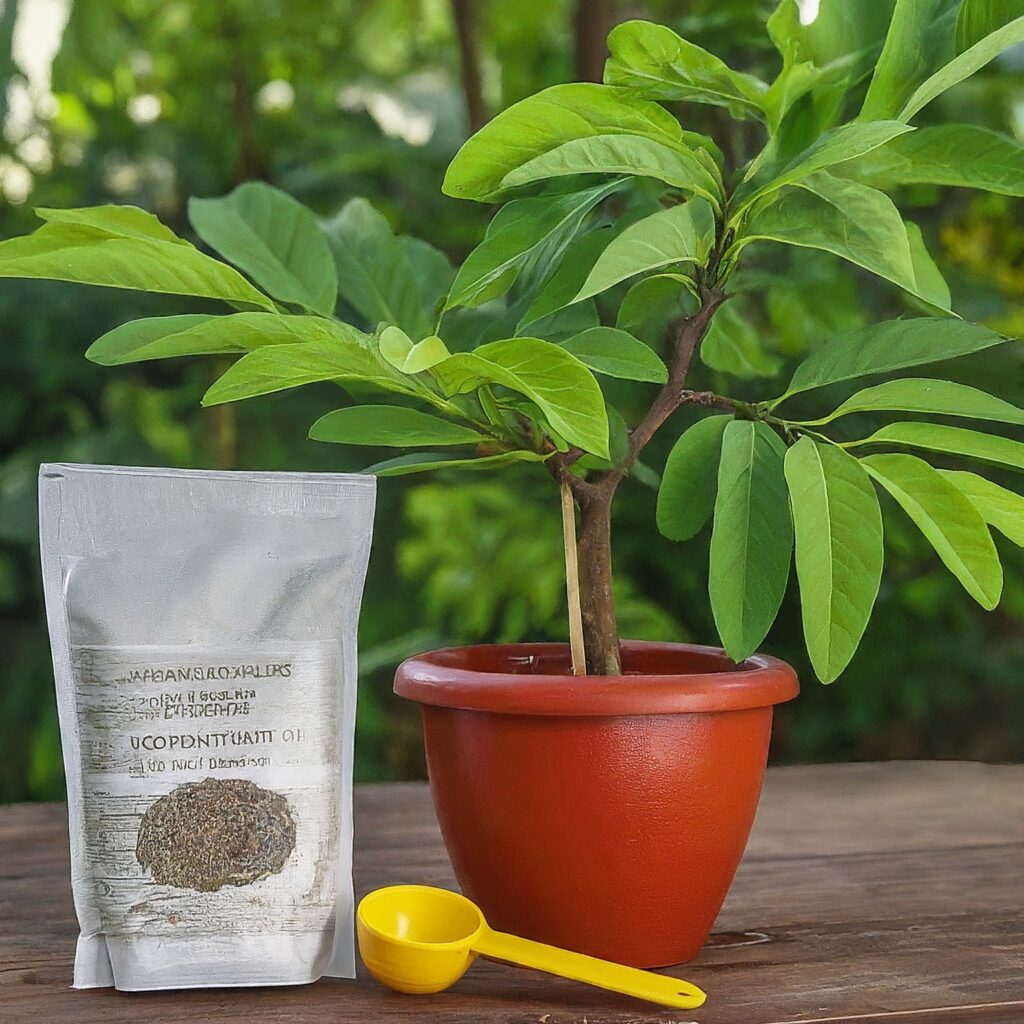
Fertilize your red custard apple tree with a balanced fertilizer during the growing season.
A fertilizer with equal parts nitrogen, phosphorus, and potassium (such as 10-10-10) works well. Want to take the DIY route? Check out how to make nitrogen fertilizer at home.
Feed your plant every 6-8 weeks during the growing season to ensure it gets the nutrients it needs.
- Early Spring: Apply the first dose of fertilizer in early spring as this is the time when new growth begins.
- Mid-Spring to Early Summer: Continue fertilizing every 6-8 weeks, adjusting the amount based on the tree’s growth and health.
- Late Summer: Reduce the frequency of fertilizing in late summer to allow the tree to harden off before winter.
Monitor the tree for signs of nutrient deficiencies, such as yellowing leaves or stunted growth, and adjust your fertilization schedule accordingly.
Step 6: Pruning
Pruning is essential for maintaining the shape and health of your red custard apple tree. Consider pruning the plant in late winter or early spring.
Here’s a detailed guide on red custard tree pruning:
- Remove Dead or Diseased Wood: Cut out any dead, damaged, or diseased branches to prevent the spread of diseases and pests.
- Thin Out Crowded Areas: Cut off stems or branches crossing or rubbing against each other. This improves air circulation and light penetration, promoting healthy growth and reducing the risk of fungal diseases.
- Shape the Tree: Prune to maintain an open, vase-like shape, which allows light to reach the inner branches and fruit. This also makes harvesting easier.
- Control Height and Spread: Regularly prune the tree to control its height and spread, making it easier to manage and harvest.
Maintain healthy trees with clean cuts! Use sharp pruning tools to minimize damage. Don’t forget to disinfect your tools between cuts to prevent the spread of diseases.
Here’s a video on how to prune red custard apple or sugar apple tree:
Step 7: Pest and Disease Management
Red custard apple trees can be susceptible to pests and diseases. Regular monitoring and early intervention are key to keeping your tree healthy.
Common Pests
- Aphids: These small, soft-bodied insects suck sap from the leaves, causing them to curl and yellow. Eliminate aphids naturally by using insecticidal soap or neem oil.
- Mealybugs: Keep an eye out for white, fluffy patches on leaves and stems – these could be mealybugs!. Remove manually or use horticultural oil to get rid of mealybugs.
- Scale Insects: These hard-shelled pests attach themselves to branches and leaves, sucking sap and excreting honeydew, which attracts sooty mold. Use a horticultural oil or insecticidal soap to control scales on your red custard apple plant.
Common Diseases
- Anthracnose: This fungal disease causes dark, sunken lesions on leaves, stems, and fruit. You can prevent it with good air circulation and avoid overhead watering. If it appears, apply a copper-based fungicide.
- Root Rot: Caused by waterlogged soil, root rot leads to yellowing leaves and wilting. Plant it in well-draining soil and water deeply but infrequently to prevent root rot.
Step 8: Harvesting Your Red Custard Apple
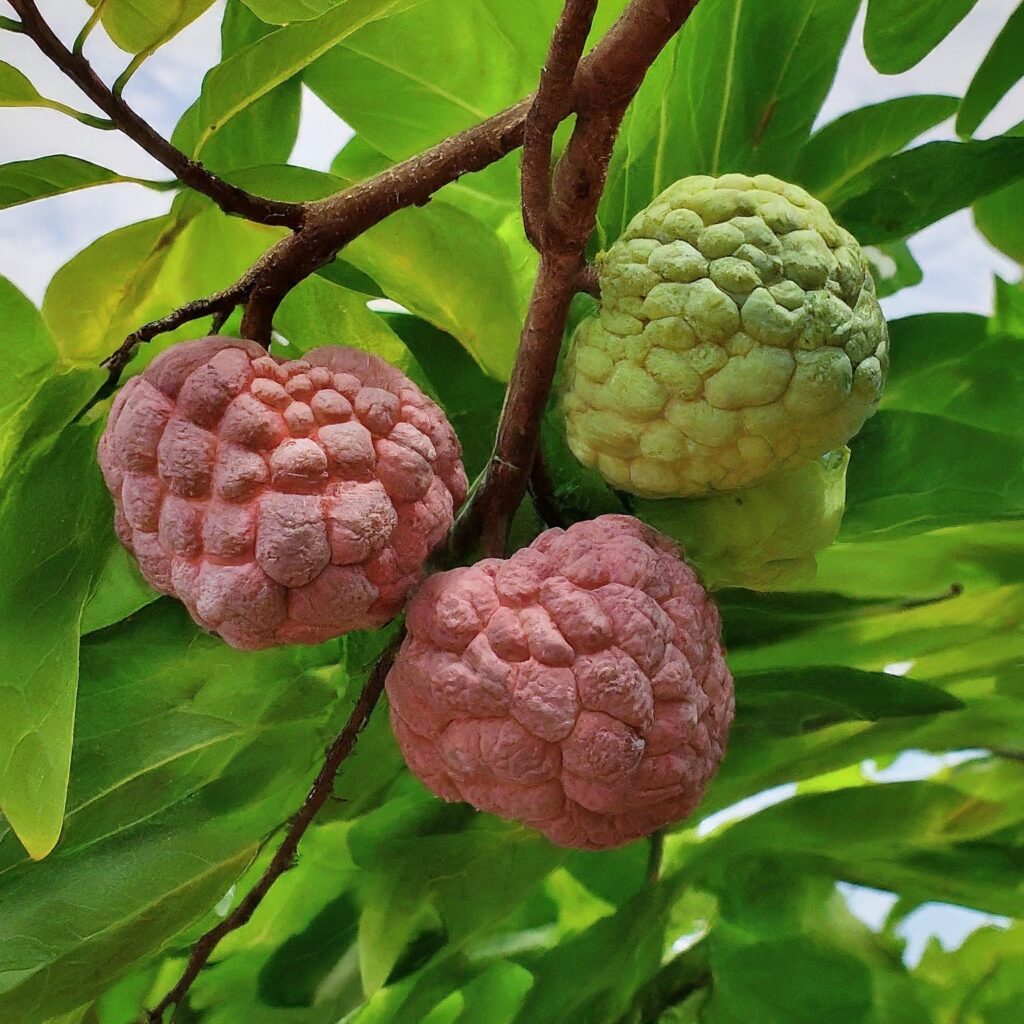
Red custard apples typically take 4-5 years to start bearing fruit. The fruit is ready to harvest when it changes color and feels slightly soft to the touch.
Here’s how to harvest your red custard apples:
- Check Ripeness: The fruit should have a slight give when gently squeezed and should emit a sweet aroma.
- Harvest Carefully: Use a sharp knife or pruning shears to cut the fruit from the tree, leaving a small stem attached. Handle the fruit carefully to prevent bumps and bruises.
- Ripen Indoors: If the fruit isn’t fully ripe, you can leave it at room temperature for a few days until it softens. Refrigerate your fruit after it ripens to slow down spoilage.
How to Propagate Red Custard Apple
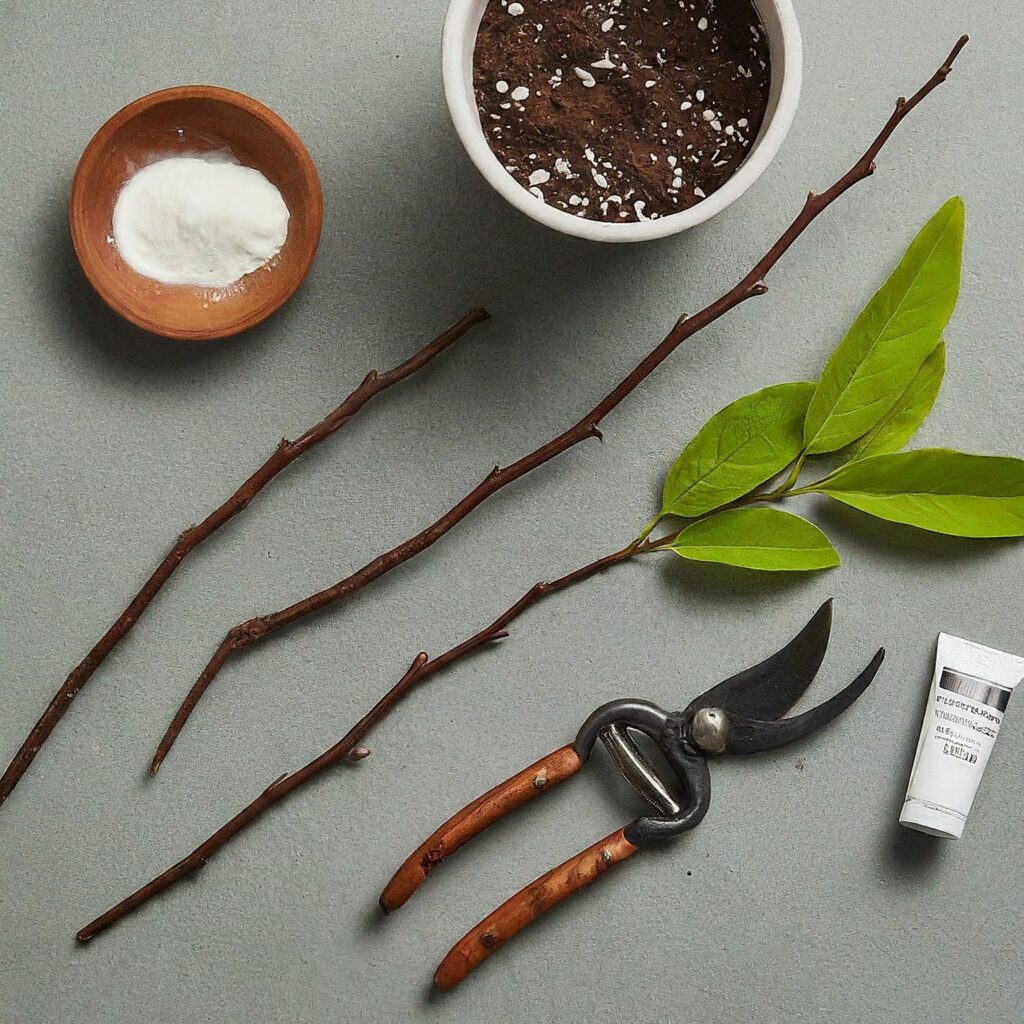
Propagation is an exciting part of gardening, allowing you to multiply your plants.
Here’s how you can propagate your red custard apple tree through stem cuttings.
Best Time to Propagate
The best time to propagate a red custard apple tree is during the warmer months, ideally late spring to early summer. This timing ensures that the cuttings have the optimal conditions for rooting.
Steps for Propagation
- Select Healthy Cuttings: Choose healthy, non-flowering stems about 6-8 inches long from the current year’s growth. Make sure the cuttings are free from pests and diseases.
- Prepare the Cuttings: Clear the lower half of your cutting and coat the stem in rooting hormone to encourage strong roots.
- Plant the Cuttings: Fill a pot with a well-draining propagation mix, such as a blend of sand and peat moss. Insert the cuttings into the soil, ensuring that at least one node is buried.
- Water and Cover: Water the cuttings thoroughly and cover the pot with a plastic bag to create a humid environment. Place the pot in a warm, shaded area to encourage rooting.
- Monitor and Transplant: Keep an eye on your cuttings for signs of new roots. Once roots have formed, which can take several weeks, transplant the new plants into individual pots or directly into the garden.
Red Custard Apple Benefits
The red custard apple is not only a treat for your taste buds but also offers numerous health benefits.
Here are some of the top red custard apple benefits:
Nutrient-Rich
Red custard apples are packed with essential nutrients, including vitamins C and B6, magnesium, potassium, and dietary fiber. These nutrients promote healthy digestion while also contributing to overall health and a strong immune system.
Antioxidant Properties
The fruit is rich in antioxidants, which help combat oxidative stress and reduce inflammation in the body. This can lower the risk of chronic diseases such as heart disease and cancer.
Supports Heart Health
The high levels of potassium and magnesium in red custard apples help regulate blood pressure and support heart health. What’s more, the fiber in these nutrients also helps lower cholesterol.
Enhances Digestive Health
The dietary fiber in red custard apples promotes healthy digestion by preventing constipation and supporting the growth of beneficial gut bacteria.
Boosts Immunity
With its high vitamin C content, the red custard apple helps strengthen the immune system, making it easier for your body to fend off infections.
How to Tackle Common Problems with Growing Red Custard Apple Tree
Like any plant, the red custard apple tree can face several challenges. Here are some common issues your plant might experience and tips on how to manage them:
Poor Fruit Production
If your tree isn’t producing fruit, it could be due to poor pollination, inadequate sunlight, or nutrient deficiencies.
- Ensure your tree is planted in a sunny location, and consider hand-pollinating flowers to improve fruit setting.
- Regular fertilization with a balanced fertilizer can also boost fruit production.
Environmental Stress
Red custard apple trees are sensitive to cold temperatures and can suffer from frost damage. If you live in a cooler climate, consider planting your tree in a protected area or using frost clothes during cold snaps.
Conclusion
Growing a red custard apple tree can be a delightful and rewarding experience. As such, there’s no reason why you shouldn’t level up your garden with this beauty! Enjoy its unique look and delicious fruit, and reap the health rewards. Follow the steps outlined in this guide and you’ll be well on your way to successfully cultivating your own red custard apple.
